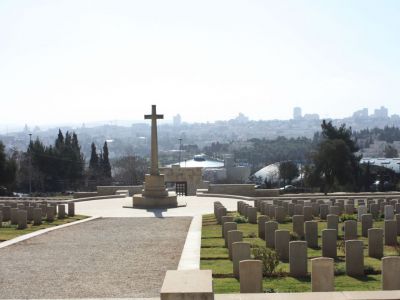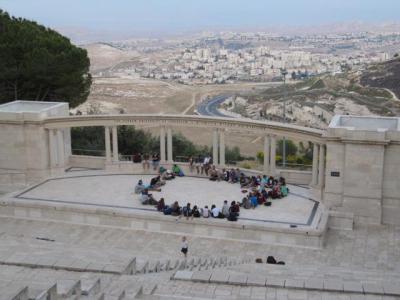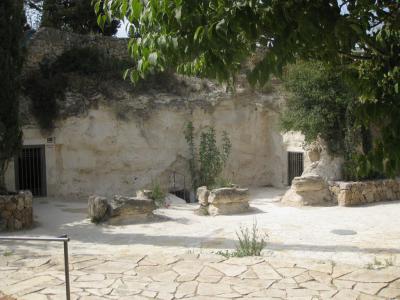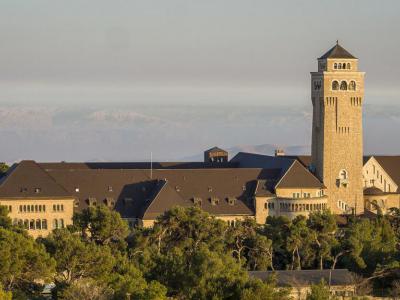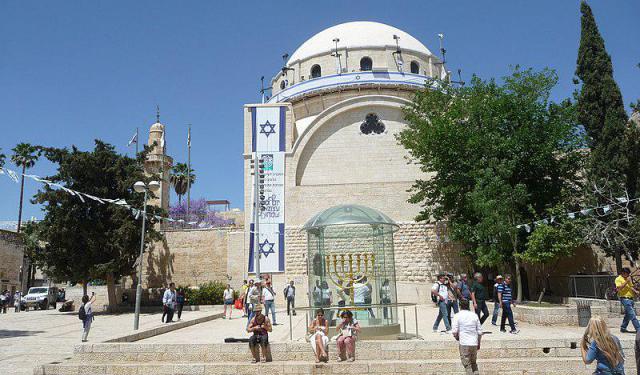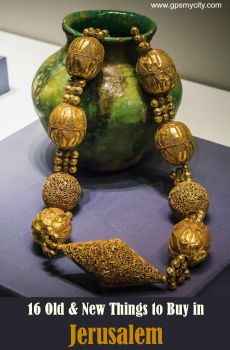Mount Scopus Walking Tour (Self Guided), Jerusalem
Dotted with many sightseeing places, Mount Scopus – translating as the “Observation Mount” from Greek – is a great place to get views over the whole Old City of Jerusalem on a nice day. The mount has been of major strategic importance since Roman times, with forces setting up camp here prior to laying the siege that culminated in the final Roman victory over Jerusalem around 70 AD. Likewise, the Crusaders camped on the mount in 1099 just before taking the city from the Fatimid Caliphate, as did the British after taking it in 1917 from the Ottoman Empire.
The best time to visit is evening, when the sunset will be just in front of you with a magnificent city-view. Passing through the War Cemetery, you’ll reach the sought-after Hebrew University campus with its botanical garden and amphitheater, the latter affording magnificent views over the Judaean Desert as far as the Mountains of Moab. Elsewhere, the top of Mount Scopus gives a good panoramic view over the Mount of Olives, as well as the ramparts and fortified gates of the Old City, with the Dome of the Rock clearly visible.
Make sure to also check the Augusta Victoria compound with a hospital (East Jerusalem’s largest) and a beautiful church. Those who are fit can climb up the many stairs of the tower and look as far as the Dead Sea.
Follow our self-guided walking tour to have a great time in this magical place!
The best time to visit is evening, when the sunset will be just in front of you with a magnificent city-view. Passing through the War Cemetery, you’ll reach the sought-after Hebrew University campus with its botanical garden and amphitheater, the latter affording magnificent views over the Judaean Desert as far as the Mountains of Moab. Elsewhere, the top of Mount Scopus gives a good panoramic view over the Mount of Olives, as well as the ramparts and fortified gates of the Old City, with the Dome of the Rock clearly visible.
Make sure to also check the Augusta Victoria compound with a hospital (East Jerusalem’s largest) and a beautiful church. Those who are fit can climb up the many stairs of the tower and look as far as the Dead Sea.
Follow our self-guided walking tour to have a great time in this magical place!
How it works: Download the app "GPSmyCity: Walks in 1K+ Cities" from Apple App Store or Google Play Store to your mobile phone or tablet. The app turns your mobile device into a personal tour guide and its built-in GPS navigation functions guide you from one tour stop to next. The app works offline, so no data plan is needed when traveling abroad.
Mount Scopus Walking Tour Map
Guide Name: Mount Scopus Walking Tour
Guide Location: Israel » Jerusalem (See other walking tours in Jerusalem)
Guide Type: Self-guided Walking Tour (Sightseeing)
# of Attractions: 6
Tour Duration: 1 Hour(s)
Travel Distance: 2.3 Km or 1.4 Miles
Author: vickyc
Sight(s) Featured in This Guide:
Guide Location: Israel » Jerusalem (See other walking tours in Jerusalem)
Guide Type: Self-guided Walking Tour (Sightseeing)
# of Attractions: 6
Tour Duration: 1 Hour(s)
Travel Distance: 2.3 Km or 1.4 Miles
Author: vickyc
Sight(s) Featured in This Guide:
- British War Cemetery (Mount Scopus)
- Hebrew University (Mt. Scopus Campus)
- National Botanical Gardens (Mount Scopus)
- Burial Cave of Nicanor
- Hecht Synagogue
- Augusta Victoria Hospital / Church of the Ascension
1) British War Cemetery (Mount Scopus)
Just northwest of the renowned Hadassah Hospital, the War Cemetery on Mount Scopus serves as the final resting place for fallen servicemen of the British Commonwealth during the Palestine campaign of 1917. The first real attempt at providing a unified burial ground for those who perished on foreign soil, it houses the graves of 2,515 Commonwealth service personnel (including 100 unidentified individuals), a number of whom were relocated from at leat seven other cemeteries in the vicinity to ensure proper maintenance.
In addition to units from the United Kingdom, Australia, New Zealand, India, Egypt, South Africa, and the British West Indies, a small number of German and Turkish soldiers are also laid to rest here, with a small section dedicated to Jewish soldiers near Plot 'N'. Moreover, the site features the Jerusalem Memorial honoring 3,300 Commonwealth service personnel who lost their lives in operations during the same war in Egypt and Palestine, their graves unknown. This memorial includes a chapel with a mosaic designed by Robert Anning Bell.
Maintained with precision, the cemetery's serene grounds and simple burial markers poignantly reflect the harsh realities of war. Each stone bears the name, age, date of death, and unit insignia of the soldier. Visitation is free and open to the public 24/7, though it's advisable to explore during daylight hours for safety and appreciation of the solemn surroundings.
In addition to units from the United Kingdom, Australia, New Zealand, India, Egypt, South Africa, and the British West Indies, a small number of German and Turkish soldiers are also laid to rest here, with a small section dedicated to Jewish soldiers near Plot 'N'. Moreover, the site features the Jerusalem Memorial honoring 3,300 Commonwealth service personnel who lost their lives in operations during the same war in Egypt and Palestine, their graves unknown. This memorial includes a chapel with a mosaic designed by Robert Anning Bell.
Maintained with precision, the cemetery's serene grounds and simple burial markers poignantly reflect the harsh realities of war. Each stone bears the name, age, date of death, and unit insignia of the soldier. Visitation is free and open to the public 24/7, though it's advisable to explore during daylight hours for safety and appreciation of the solemn surroundings.
2) Hebrew University (Mt. Scopus Campus)
Renowned for its cutting-edge research in fields like medicine and science, and serving as a hub for students hailing from all corners of the globe, the Hebrew University on Mount Scopus presents itself from a distance like a high-tech fortress straight out of a James Bond movie – one that could vanish underground with the push of a button. Although it temporarily relocated after 1948, it returned to its expanded grounds post-1967, now accompanied by vast new government edifices.
With its inviting ambiance and striking architecture complemented by lush greenery, flowers, inviting park benches, and secluded romantic nooks, the campus notably features an amphitheater nestled on its eastern fringe, offering magnificent vistas stretching over the Judaean Desert to the distant Mountains of Moab.
Counting luminaries such as Martin Buber, Sigmund Freud, and Albert Einstein among its first board members, the University maintains notoriously rigorous admission standards; however, anyone can leisurely wander amidst its buildings and bask in the inspiration of its unique skyline. For those seeking wellness amenities, the reasonably priced health club has a range of offerings including a swimming pool, tennis and squash courts, weight training facilities, an aerobic center, and a spa complete with steam rooms, saunas, and jacuzzis.
With its inviting ambiance and striking architecture complemented by lush greenery, flowers, inviting park benches, and secluded romantic nooks, the campus notably features an amphitheater nestled on its eastern fringe, offering magnificent vistas stretching over the Judaean Desert to the distant Mountains of Moab.
Counting luminaries such as Martin Buber, Sigmund Freud, and Albert Einstein among its first board members, the University maintains notoriously rigorous admission standards; however, anyone can leisurely wander amidst its buildings and bask in the inspiration of its unique skyline. For those seeking wellness amenities, the reasonably priced health club has a range of offerings including a swimming pool, tennis and squash courts, weight training facilities, an aerobic center, and a spa complete with steam rooms, saunas, and jacuzzis.
3) National Botanical Gardens (Mount Scopus)
It's worth the extra climb to the top of Mount Scopus and explore the Hebrew University's botanical garden. Established in the 1920s, it contains a fairly complete collection of nearly 1,000 species of wild plants sourced from across Israel and the Middle East – from lovely bluish-purple orchids to specimens mentioned in the Bible (sesame, saffron, almonds, figs, etc.), all set against the backdrop of a picturesque lake. While some plants may be seasonal and not always on display, the garden remains an excellent spot for studying the region's diverse flora. Don't forget to grab a brochure or use your mobile device to learn more about any plant that catches your interest.
From the summit, you'll be treated to a great panoramic view of Jerusalem city. Just below and to the left lie the Mount of Olives and several significant sites such as the Church of All Nations, Mary's Tomb, and the gold onion-domed Church of Mary Magdalene. Directly ahead, you'll see the ancient ramparts and fortified gates of the Old City, with the iconic Dome of the Rock standing out prominently.
While visiting, take advantage of the few hammocks available for public use, explore the reconstructed watchman's hut (reminiscent of those that once dotted every farm in the area), and marvel at the ancient burial caves dating back to the first century AD.
From the summit, you'll be treated to a great panoramic view of Jerusalem city. Just below and to the left lie the Mount of Olives and several significant sites such as the Church of All Nations, Mary's Tomb, and the gold onion-domed Church of Mary Magdalene. Directly ahead, you'll see the ancient ramparts and fortified gates of the Old City, with the iconic Dome of the Rock standing out prominently.
While visiting, take advantage of the few hammocks available for public use, explore the reconstructed watchman's hut (reminiscent of those that once dotted every farm in the area), and marvel at the ancient burial caves dating back to the first century AD.
4) Burial Cave of Nicanor
Within the botanical gardens of the Hebrew University's Mount Scopus Campus, a small set of burial caves have been expertly preserved and are open to the public. Here, visitors can marvel at original ossuaries that have remained undisturbed for thousands of years. Unlike seeing them in a museum, here you can examine authentic burial artifacts in their original context – and best of all, it's free of charge.
Among the ossuaries is one belonging to a Jewish benefactor named Nicanor, famed in ancient sources for his donation of the gates of the Second Jewish Temple (516BC-70AD). Legend has it that these brass gates were being transported by ship from Egypt to Judea when a fierce storm erupted, prompting the crew to toss one overboard. Unsuccessful in calming the tempest, they decided to discard the second gate as well. In a remarkable act of self-sacrifice, Nicanor insisted that if they cast the gate into the sea, they must also cast him out. Miraculously, the storm ceased upon his declaration; moreover, upon docking, the gate thrown into the sea was found floating in the harbor. Interestingly, all the Temple's gates were plated with gold except for Nicanor's, as the rabbis wished for the people to witness the "miracle gates" in their original bronze form. Besides, their brass finish happened to have a special golden hue – or so the Talmud says…
Tip: Remember to bring your ID for entry into the university campus.
Among the ossuaries is one belonging to a Jewish benefactor named Nicanor, famed in ancient sources for his donation of the gates of the Second Jewish Temple (516BC-70AD). Legend has it that these brass gates were being transported by ship from Egypt to Judea when a fierce storm erupted, prompting the crew to toss one overboard. Unsuccessful in calming the tempest, they decided to discard the second gate as well. In a remarkable act of self-sacrifice, Nicanor insisted that if they cast the gate into the sea, they must also cast him out. Miraculously, the storm ceased upon his declaration; moreover, upon docking, the gate thrown into the sea was found floating in the harbor. Interestingly, all the Temple's gates were plated with gold except for Nicanor's, as the rabbis wished for the people to witness the "miracle gates" in their original bronze form. Besides, their brass finish happened to have a special golden hue – or so the Talmud says…
Tip: Remember to bring your ID for entry into the university campus.
5) Hecht Synagogue
The main synagogue at the Hebrew University's Mount Scopus campus is a grand structure known for its striking design and remarkable features. Of particular note is the unique arrangement of the Torah Ark window, offering a panoramic view of the Old City, the Judaean Mountains, and even the Herodium Hill on the horizon. As such, it's the only place in the world where one can pray while overlooking the Temple Mount. Daily services are held at various times throughout the day, except on the Jewish Sabbath and holidays, providing opportunities for all to visit and participate.
Funded by the Hecht family in memory of Mayer Jacob Hecht (1928-2006), former US Republican Senator of Nevada and US Ambassador to the Bahamas, the construction faced challenges, including a temporary halt during the Yom Kippur War in 1973. However, with government support for completing the campus and fortifying the site, the synagogue was completed in 1981. Built with a minimalist approach, it features white Jerusalem stone and plaster, creating a fortress-like exterior with angular geometrical angles inside.
Tip:
Don't miss exploring the balcony and roof for an even more breathtaking view from the outside.
Funded by the Hecht family in memory of Mayer Jacob Hecht (1928-2006), former US Republican Senator of Nevada and US Ambassador to the Bahamas, the construction faced challenges, including a temporary halt during the Yom Kippur War in 1973. However, with government support for completing the campus and fortifying the site, the synagogue was completed in 1981. Built with a minimalist approach, it features white Jerusalem stone and plaster, creating a fortress-like exterior with angular geometrical angles inside.
Tip:
Don't miss exploring the balcony and roof for an even more breathtaking view from the outside.
6) Augusta Victoria Hospital / Church of the Ascension
Established in 1910 to serve Palestine's German Protestant community, this hospital, named after Kaiser Wilhelm II's wife, stands as one of East Jerusalem's largest medical facilities and remains the sole specialized-care institution in the West Bank and Gaza Strip. Although officially inaugurated in 1910, the construction - architectually inspired by German palaces like the Hohenzollern Castle – was not completed until 1914. Back then, it was the country's first building to be equipped with electricity, powered by a diesel generator.
Within the hospital grounds is the Church of the Ascension, characterized by its distinctive high square tower housing four large bells, including one weighing six tons. This tower serves as a prominent landmark visible throughout the city and offers panoramic views stretching all the way to the Dead Sea. While the church is open to the public from Monday to Saturday (8:30 AM–1 PM), please note that the lift has been out of service for several years, requiring visitors to climb the stairs to reach the top. Standing at 60 meters high, the ascent can be quite challenging for those averse to stairs. Adorned with intricate domes and artwork, the church building itself occasionally hosts choral and classical music concerts, with event details available on the website.
Within the hospital grounds is the Church of the Ascension, characterized by its distinctive high square tower housing four large bells, including one weighing six tons. This tower serves as a prominent landmark visible throughout the city and offers panoramic views stretching all the way to the Dead Sea. While the church is open to the public from Monday to Saturday (8:30 AM–1 PM), please note that the lift has been out of service for several years, requiring visitors to climb the stairs to reach the top. Standing at 60 meters high, the ascent can be quite challenging for those averse to stairs. Adorned with intricate domes and artwork, the church building itself occasionally hosts choral and classical music concerts, with event details available on the website.
Walking Tours in Jerusalem, Israel
Create Your Own Walk in Jerusalem
Creating your own self-guided walk in Jerusalem is easy and fun. Choose the city attractions that you want to see and a walk route map will be created just for you. You can even set your hotel as the start point of the walk.
Armenian Quarter Walking Tour
Smaller and quieter than the Old City's other three quarters, the Armenian quarter contains a series of winding cobblestoned streets and alleyways teeming with people, shops, coffee stands, ceramic workshops and hookah bars. A city in miniature with distinct language, alphabet and culture, it has been in place since the 4th century, when Armenia adopted Christianity as a national religion.
... view more
Tour Duration: 1 Hour(s)
Travel Distance: 1.2 Km or 0.7 Miles
... view more
Tour Duration: 1 Hour(s)
Travel Distance: 1.2 Km or 0.7 Miles
Jerusalem City Gates Walking Tour
Historians believe that the Old City of Jerusalem probably came into being more than 4,500 years ago. The defensive wall around it features a number of gates built on the order of the Ottoman sultan Suleyman the Magnificent in the first half of the 16th century, each of which is an attraction in its own right. Until as recently as 1870, they were all closed from sunset to sunrise; nowadays, just... view more
Tour Duration: 2 Hour(s)
Travel Distance: 3.7 Km or 2.3 Miles
Tour Duration: 2 Hour(s)
Travel Distance: 3.7 Km or 2.3 Miles
Mount Zion Walking Tour
For those interested in religion and history, Mount Zion offers several unique sights that are situated in close proximity to each other. An important place for Christians, Jews as well as Muslims, it holds important constructions dating from the 20th century as well as a compound built by the Crusaders that marks the spot of both King David’s tomb and the Room of the Last Supper. How... view more
Tour Duration: 1 Hour(s)
Travel Distance: 1.0 Km or 0.6 Miles
Tour Duration: 1 Hour(s)
Travel Distance: 1.0 Km or 0.6 Miles
Jewish Quarter Walking Tour
Entirely rebuilt in the 1980s after having been largely destroyed during the 1948 War, the Jewish Quarter is quite distinct from the rest of the Old City. Good signposting, spacious passageways, art galleries and a somewhat less buzzing atmosphere make the area a relaxing place to spend some time.
With its rebuilt residential buildings, some almost consider this area the "New... view more
Tour Duration: 1 Hour(s)
Travel Distance: 1.3 Km or 0.8 Miles
With its rebuilt residential buildings, some almost consider this area the "New... view more
Tour Duration: 1 Hour(s)
Travel Distance: 1.3 Km or 0.8 Miles
Christian Quarter Walking Tour
One of the epicenters of worldwide Christianity, the Christian Quarter is the 2nd-largest of Jerusalem’s four ancient quarters. A fascinating place to stroll through, it covers the Old City’s northwestern part, just beyond Jaffa Gate – the traditional pilgrim’s entrance to Jerusalem and a prime destination for most visitors.
With its tangle of broad streets and winding, narrow alleys,... view more
Tour Duration: 1 Hour(s)
Travel Distance: 1.1 Km or 0.7 Miles
With its tangle of broad streets and winding, narrow alleys,... view more
Tour Duration: 1 Hour(s)
Travel Distance: 1.1 Km or 0.7 Miles
Muslim Quarter & Temple Mount Tour
The largest, most populous and perhaps most chaotic of all Jerusalem’s quarters, the Muslim Quarter is worth exploring for its unique atmosphere. Spending a day here may take you back to a simpler time, but be prepared for many sights and sounds as you pass many vendors, stores and restaurants on your way from site to site.
Some of the city’s most interesting city gates (Damascus and... view more
Tour Duration: 2 Hour(s)
Travel Distance: 2.1 Km or 1.3 Miles
Some of the city’s most interesting city gates (Damascus and... view more
Tour Duration: 2 Hour(s)
Travel Distance: 2.1 Km or 1.3 Miles
Useful Travel Guides for Planning Your Trip
16 Uniquely Israel Things to Buy in Jerusalem
Modern day Jerusalem is a mosaic of neighborhoods, reflecting different historical periods, cultures, and religions. The influx of repatriates in recent years has made the cultural and artisanal scene of the city even more colourful and diverse. To find your way through Jerusalem's intricate...
The Most Popular Cities
/ view all



